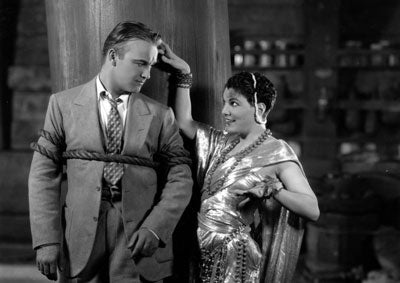Directed by Paul Sloane
DeMille Pictures Corp./Producers Distributing Corp. Screenwriters: Elmer Harris, Jack Jevne. Cinematographer: Arthur Miller. Editor: Elmer Harris. With: Leatrice Joy, William Boyd, Robert Edeson, Walter Long, Richard Carle. 35mm, b/w, approx. 75 min.
After parting ways with Famous Players-Lasky (Paramount) in early 1925, famed director Cecil B. DeMille decided to try his own hand at playing studio boss, and subsequently purchased the Thomas H. Ince studios in Culver City for $500,000. Rechristened the DeMille Studios, production quickly began on the first year’s program of 12 films—one of which was to be Eve’s Leaves.
Based on the play by Harry Chapman Ford and directed by Paul Sloane, the story involves a well-meaning sea captain who forces his daughter Eve (Leatrice Joy) to masquerade as a boy in a misguided attempt to protect her from the evils of the outside world—and possibly, to stifle her nascent interest in the opposite sex. Eve responds by provoking widespread mischief aboard her father’s tramp freighter (ironically named “The Garden of Eden”) which culminates with the shanghaiing of handsome—but disinterested— Bob Britton (William Boyd). When Chinese marauders capture the ship, gang leader Chang Fang (Walter Long) discovers Eve’s true identity and schemes to add her to his illicit possessions.
While the plot of Eve’s Leaves is loosely framed by melodrama, it is comedy that forms the true heart of this movie. Leatrice Joy, who had followed DeMille over from Paramount, displays her considerable talent as comedienne in the lead role of Eve—one of several masculine-feminine characters that she would play during the 1920s. William Boyd, who would later achieve greater fame as cowboy hero Hopalong Cassidy, is commendable as the object of Eve’s desire; but while their combined screen chemistry is palpable (as witnessed in the truly memorable “apple-kissing” scene), it is Joy’s ebullient performance that ultimately steals the show.
DeMille’s own directorial successes such as The Volga Boatman (which featured Boyd in his first starring role) and The King Of Kings were not enough to overcome his studio’s overall poor three-year performance at the box- office, and he (after a brief assignment with MGM) eventually reunited with Paramount where he remained for the balance of his career. Joy, who broke with DeMille in 1928, saw her career decline rapidly after the film industry’s conversion to sound, most likely due to her southern accent.
Steven K. Hill
Preserved by The Stanford Theatre Foundation and UCLA Film & Television Archive from two 16mm prints. Laboratory services by The Stanford Theatre Film Laboratory.







